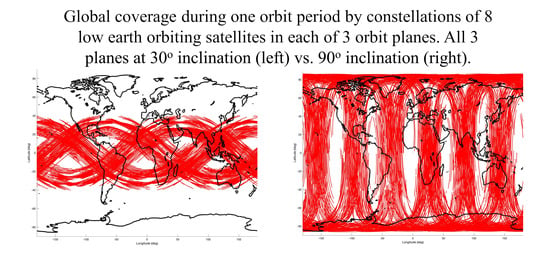Spatial and Temporal Sampling Properties of a Large GNSS-R Satellite Constellation
Abstract
1. Introduction
- Achieving a particular sampling density with the minimum number of satellites;
- Maximizing the sampling density for a given number of satellites; and
- Spreading out the samples at each location in time to better resolve diurnal variability and support the initialization of numerical weather prediction models.
2. Discussion of Orbital Parameters, Sampling Process, and SpOCK
2.1. Constellation Design Baseline Assumptions
- All satellites are in circular orbits (eccentricy = 0, AoP not relevant), all satellites within an orbital plane are equally spaced (true anomalies fixed), all satellites in the constellation are at the same altitude (semi-major axis fixed). The number of satellites, the angular spacing of the orbit planes and the inclinations of the orbit planes are the three remaining variables considered in the constellation design;
- The instruments on each satellite are constrained as follows: a dual antenna configuration of either (a) the NASA CYGNSS mission antennas or (b) a larger dual antenna design for the higher altitude orbit simulations. The instruments are all capable of tracking up to 16 specular reflection measurements in parallel, based on the current estimated capability of the next generation of GNSS-R instruments [13]. The signal strength required for viable land and ocean observations is based on CYGNSS retrievals vs. range corrected gain (RCG), which considers both antenna gain and path losses for individual surface measurements [14,15].
2.2. Overview of Observation Sampling Process and Instrument Considerations
2.2.1. GNSS-R Surface Reflection Global Distribution
2.2.2. GNSS-R Instrument Dependencies
2.3. SpOCK and Its Operation
2.4. Performance Metrics
3. GNSS-R Coverage Simulations
3.1. Effect of Orbit Inclincation on Constellation Coverage
3.2. Effect of Orbit Planes on Constellation Coverage
3.3. Effect of Measurement RCG on Constellation Coverage
4. Examples
4.1. Application of Design Methodology
4.2. Sampling of a Landfalling Hurricane
5. Conclusions
Author Contributions
Funding
Data Availability Statement
Conflicts of Interest
References
- NASEM. Leveraging Commercial Space for Earth and Ocean Remote Sensing; The National Academies Press: Washington, DC, USA, 2022. [Google Scholar] [CrossRef]
- Bussy-Virat, C.D.; Ruf, C.S.; Ridley, A.J. Relationship Between Temporal and Spatial Resolution for a Constellation of GNSS-R Satellites. IEEE J. Sel. Top. Appl. Earth Obs. Remote Sens. 2018, 12, 16–25. [Google Scholar] [CrossRef]
- Gleason, S.; Gebre-Egziabher, D. GNSS Applications and Methods, 1st ed.; Artech House: Norwood, MA, USA, 2009; p. 508. [Google Scholar]
- Katzberg, S.J.; Dunion, J.; Ganoe, G.G. The use of reflected GPS signals to retrieve ocean surface wind speeds in tropical cyclones. Radio Sci. 2013, 48, 371–387. [Google Scholar] [CrossRef]
- Unwin, M.; Jales, P.; Tye, J.; Gommenginger, C.; Foti, G.; Rosello, J. Spaceborne GNSS-Reflectometry on TechDemoSat-1: Early Mission Operations and Exploitation. IEEE J. Sel. Top. Appl. Earth Obs. Remote Sens. 2016, 9, 4525–4539. [Google Scholar] [CrossRef]
- Carreno-Luengo, H.; Lowe, S.; Zuffada, C.; Esterhuizen, S.; Oveisgharan, S. Spaceborne GNSS-R from the SMAP Mission: First Assessment of Polarimetric Scatterometry over Land and Cryosphere. Remote Sens. 2017, 9, 362. [Google Scholar] [CrossRef]
- Pierdicca, N.; Comite, D.; Camps, A.; Carreno-Luengo, H.; Cenci, L.; Clarizia, M.P.; Costantini, F.; Dente, L.; Guerriero, L.; Mollfulleda, A.; et al. The Potential of Spaceborne GNSS Reflectometry for Soil Moisture, Biomass, and Freeze–Thaw Monitoring: Summary of a European Space Agency-funded study. IEEE Geosci. Remote Sens. Mag. 2021, 10, 8–38. [Google Scholar] [CrossRef]
- Ruf, C.S.; Atlas, R.; Chang, P.S.; Clarizia, M.P.; Garrison, J.L.; Gleason, S.; Katzberg, S.J.; Jelenak, Z.; Johnson, J.T.; Majumdar, S.J.; et al. New Ocean Winds Satellite Mission to Probe Hurricanes and Tropical Convection. Bull. Am. Meteorol. Soc. 2016, 97, 385–395. [Google Scholar] [CrossRef]
- Jales, P.; Esterhuizen, S.; Masters, D.; Nguyen, V.; Nogués-Correig, O.; Yuasa, T.; Cartwright, J. The new Spire GNSS-R satellite missions and products. In Proceedings of the Image and Signal Processing for Remote Sensing XXVI 2020, Online, 20 September 2020; Volume 11533, p. 1153316. [Google Scholar] [CrossRef]
- Ruf, C.; Asharaf, S.; Balasubramaniam, R.; Gleason, S.; Lang, T.; McKague, D.; Twigg, D.; Waliser, D. In-Orbit Performance of the Constellation of CYGNSS Hurricane Satellites. Bull. Am. Meteorol. Soc. 2019, 100, 2009–2023. [Google Scholar] [CrossRef]
- Rose, R.; Ruf, C.; Rose, D.; Brummitt, M.; Ridley, A. The CYGNSS flight segment; A major NASA science mission enabled by micro-satellite technology. In Proceedings of the 2013 IEEE Aerospace Conference, Big Sky, MT, USA, 2–9 March 2013; pp. 1–13. [Google Scholar] [CrossRef]
- Roddy, D. Satellite Communications, 4th ed.; McGraw-Hill: New York, NY, USA, 2006; pp. 32–36. [Google Scholar]
- Ruf, C.; Backhus, R.; Butler, T.; Chen, C.-C.; Gleason, S.; Loria, E.; McKague, D.; Miller, R.; O’Brien, A.; van Nieuwstadt, L. Next Generation GNSS-R Instrument. In Proceedings of the IGARSS 2020-2020 IEEE International Geoscience and Remote Sensing Symposium, Waikoloa, HI, USA, 26 September–2 October 2020; pp. 3353–3356. [Google Scholar] [CrossRef]
- Gleason, S.; Ruf, C.S.; O’Brien, A.J.; McKague, D.S. The CYGNSS Level 1 Calibration Algorithm and Error Analysis Based on On-Orbit Measurements. IEEE J. Sel. Top. Appl. Earth Obs. Remote Sens. 2018, 12, 37–49. [Google Scholar] [CrossRef]
- Ruf, C.; Chang, P.; Clarizia, M.P.; Gleason, S.; Jelenak, Z.; Murray, J.; Morris, M.; Musko, S.; Posselt, D.; Provost, D.; et al. CYGNSS Handbook; Michigan Pub.: Ann Arbor, MI, USA, 2016; p. 154. ISBN 978-1-60785-380-0. [Google Scholar]
- Zavorotny, V.U.; Gleason, S.; Cardellach, E.; Camps, A. Tutorial on Remote Sensing Using GNSS Bistatic Radar of Opportunity. IEEE Geosci. Remote Sens. Mag. 2015, 2, 8–45. [Google Scholar] [CrossRef]
- Ruf, C.; Gleason, S.; McKague, D.S. Assessment of CYGNSS Wind Speed Retrieval Uncertainty. IEEE J. Sel. Topics Appl. Earth Obs. Remote Sens. 2018, 12, 87–97. [Google Scholar] [CrossRef]
- Bussy-Virat, C.; Getchius, J.; Ridley, A. The Spacecraft Orbital Characterization Kit and its Applications to the CYGNSS Mission. In Proceedings of the 2018 Space Flight Mechanics Meeting, Kissimmee, FL, USA, 8–12 January 2018. [Google Scholar] [CrossRef]
- Tan, C.; Xu, Y.; Luo, R.; Li, Y.; Yuan, C. Low Earth orbit constellation design using a multi-objective genetic algorithm for GNSS reflectometry missions. Adv. Space Res. 2022, in press. [Google Scholar] [CrossRef]
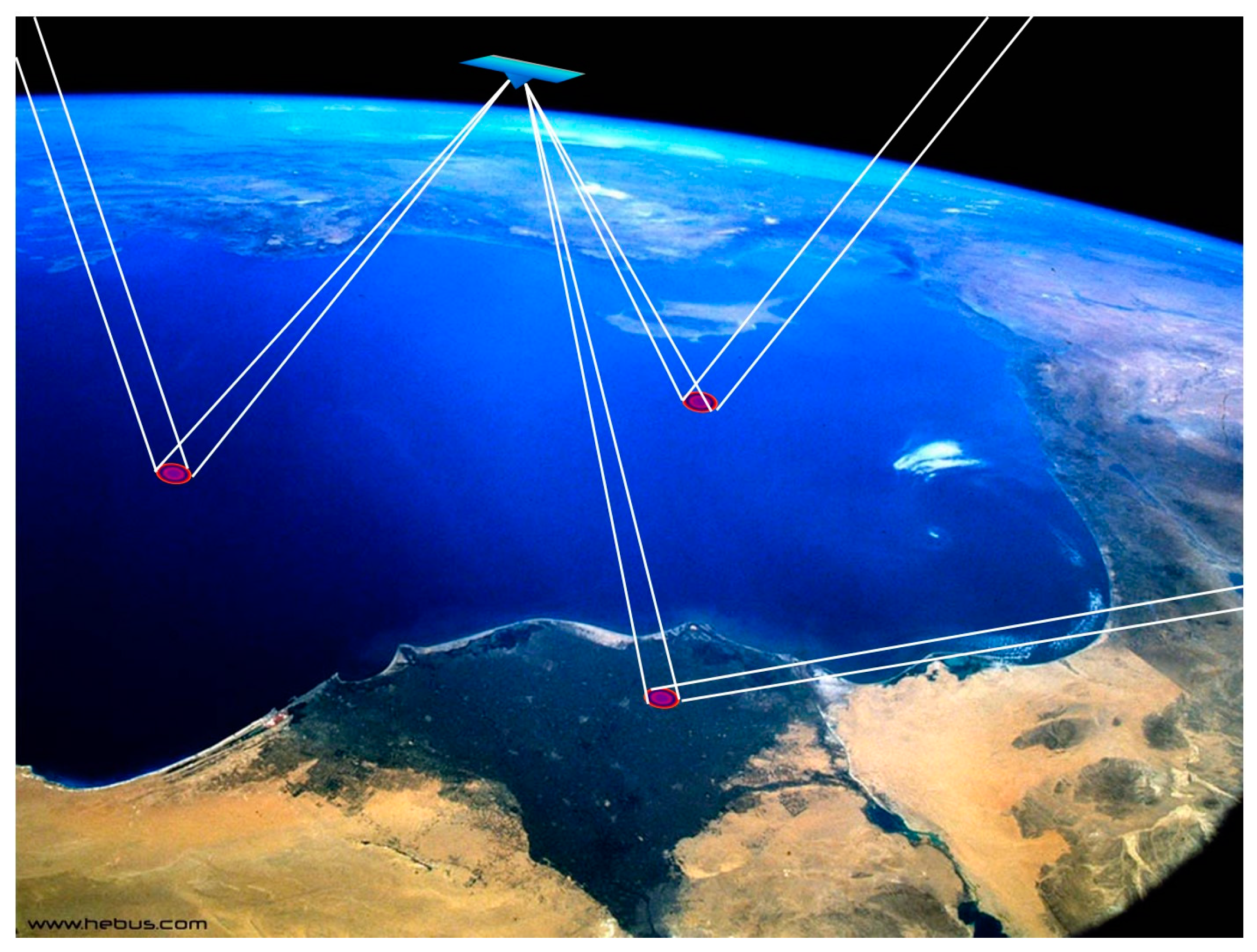



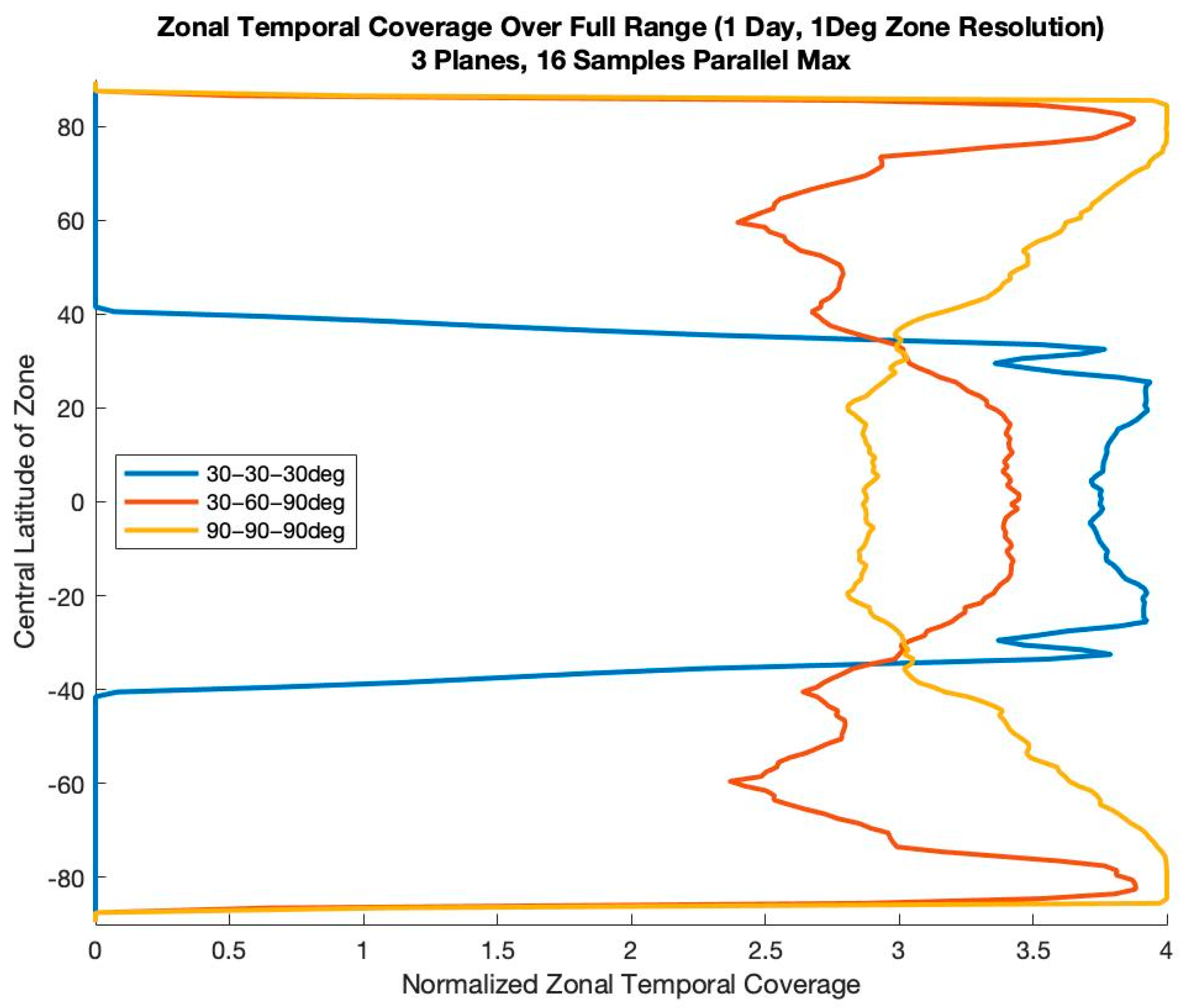

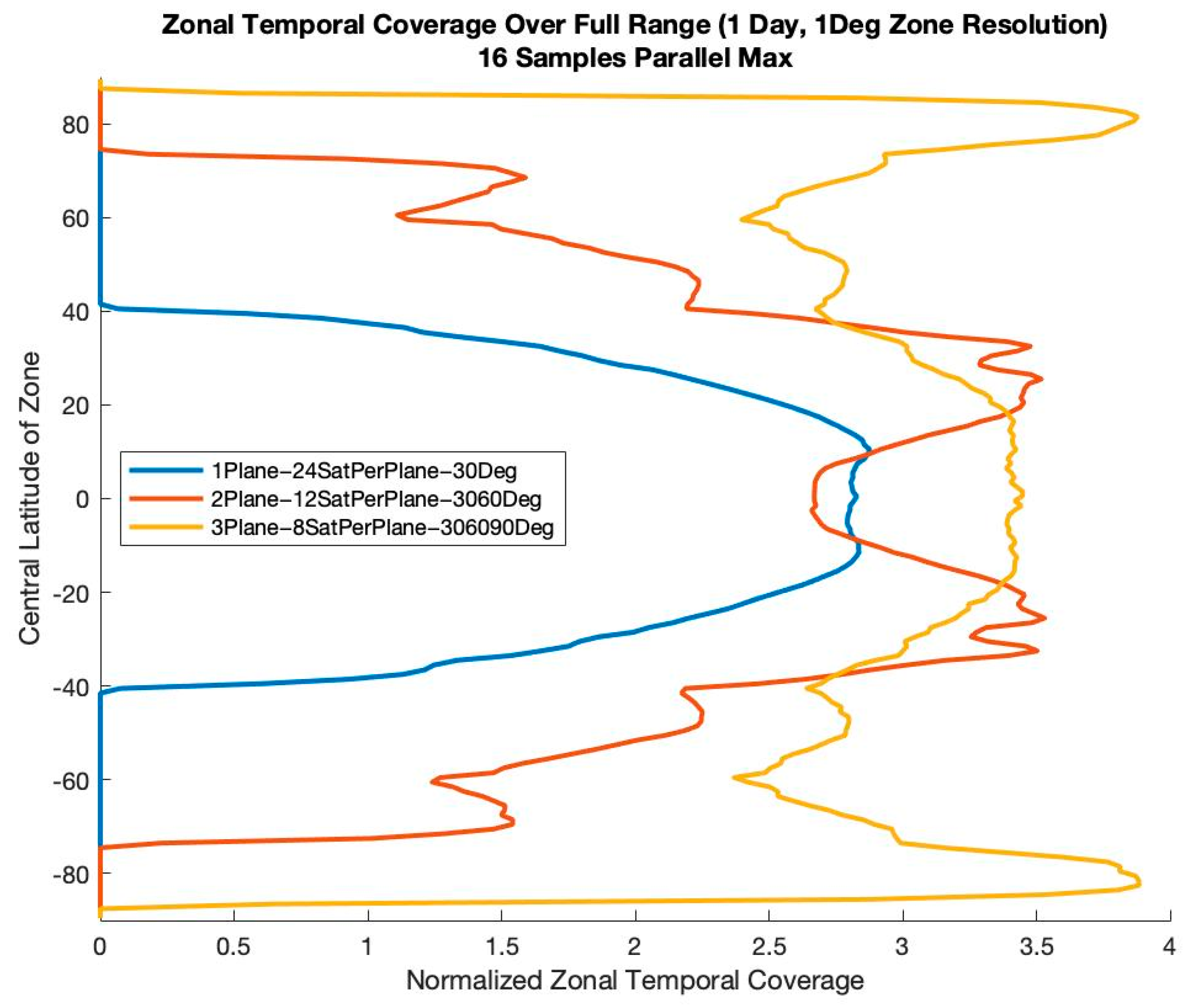

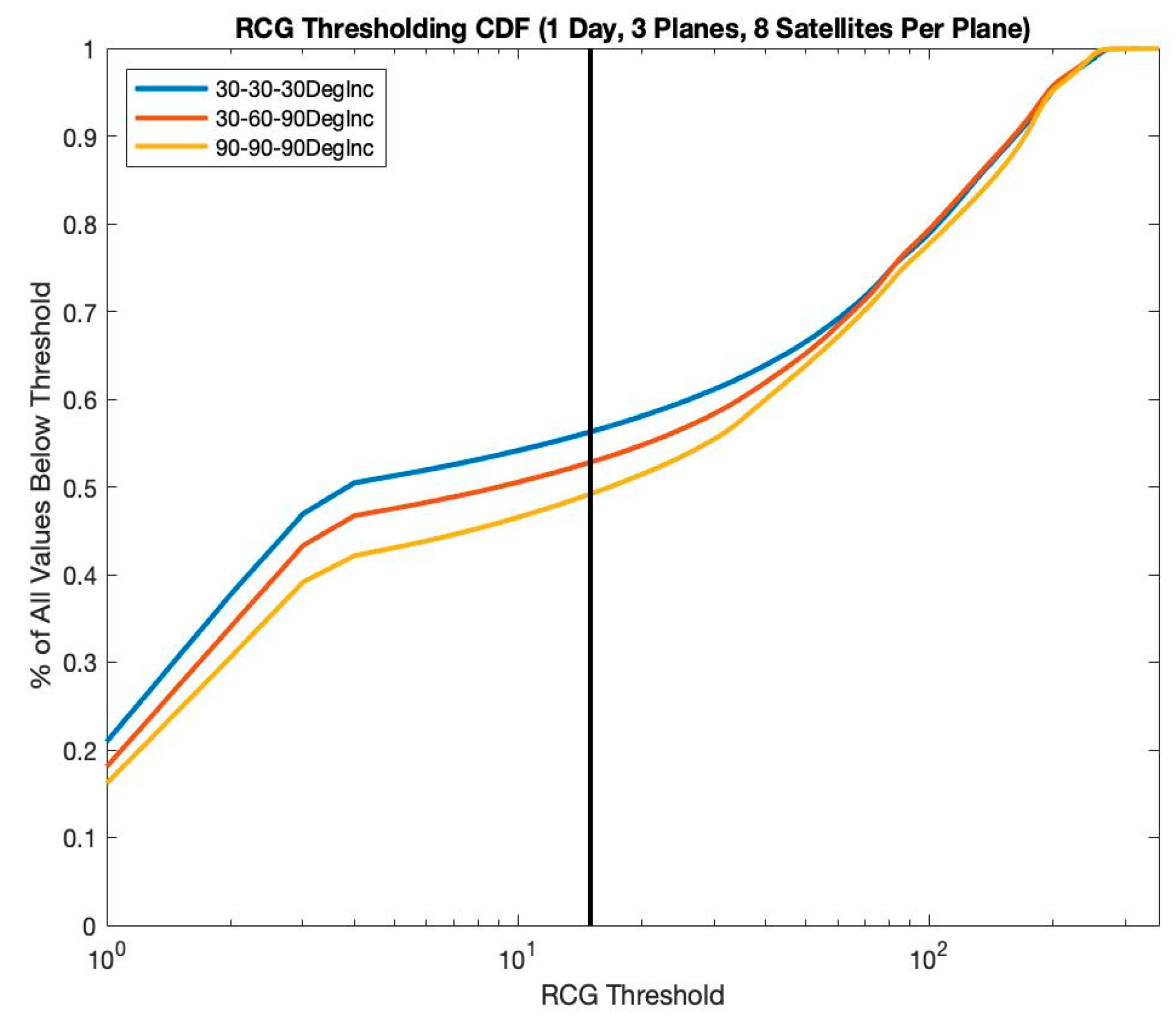

| Constellation (deg-deg-deg) | Global Spatial Coverage (%) | Global Temporal Coverage | ZSC (eq) | ZSC (mid) | ZSC (Polar) | ZTC (eq) | ZTC (mid) | ZTC (Polar) |
|---|---|---|---|---|---|---|---|---|
| 30-30-30 | 62.987 | 2.254 | 99.994 | 35.505 | 0 | 3.788 | 0.983 | 0 |
| 90-90-90 | 99.337 | 3.151 | 99.214 | 99.796 | 98.540 | 2.888 | 3.273 | 3.795 |
| 30-60-90 | 99.688 | 3.069 | 99.949 | 99.756 | 98.238 | 3.283 | 2.716 | 2.881 |
| 35-60-90 | 99.677 | 3.053 | 99.943 | 99.840 | 98.238 | 3.278 | 2.809 | 2.881 |
| 40-60-90 | 99.679 | 3.079 | 99.912 | 99.887 | 98.238 | 3.252 | 2.917 | 2.881 |
| 45-60-90 | 99.676 | 3.102 | 99.886 | 99.916 | 98.238 | 3.214 | 3.032 | 2.881 |
| 45-65-90 | 99.726 | 3.174 | 99.900 | 99.975 | 98.400 | 3.261 | 3.100 | 3.174 |
| 45-70-90 | 99.721 | 3.180 | 99.886 | 99.962 | 98.448 | 3.237 | 3.104 | 3.175 |
| 45-75-90 | 99.814 | 3.181 | 99.870 | 99.951 | 99.227 | 3.207 | 3.096 | 3.313 |
| 50-75-90 | 99.800 | 3.199 | 99.829 | 99.969 | 99.227 | 3.171 | 3.194 | 3.319 |
| 50-75-80 | 99.912 | 3.252 | 99.846 | 99.971 | 99.994 | 3.186 | 3.259 | 3.478 |
Disclaimer/Publisher’s Note: The statements, opinions and data contained in all publications are solely those of the individual author(s) and contributor(s) and not of MDPI and/or the editor(s). MDPI and/or the editor(s) disclaim responsibility for any injury to people or property resulting from any ideas, methods, instructions or products referred to in the content. |
© 2023 by the authors. Licensee MDPI, Basel, Switzerland. This article is an open access article distributed under the terms and conditions of the Creative Commons Attribution (CC BY) license (https://creativecommons.org/licenses/by/4.0/).
Share and Cite
Winkelried, J.; Ruf, C.; Gleason, S. Spatial and Temporal Sampling Properties of a Large GNSS-R Satellite Constellation. Remote Sens. 2023, 15, 333. https://doi.org/10.3390/rs15020333
Winkelried J, Ruf C, Gleason S. Spatial and Temporal Sampling Properties of a Large GNSS-R Satellite Constellation. Remote Sensing. 2023; 15(2):333. https://doi.org/10.3390/rs15020333
Chicago/Turabian StyleWinkelried, Jack, Christopher Ruf, and Scott Gleason. 2023. "Spatial and Temporal Sampling Properties of a Large GNSS-R Satellite Constellation" Remote Sensing 15, no. 2: 333. https://doi.org/10.3390/rs15020333
APA StyleWinkelried, J., Ruf, C., & Gleason, S. (2023). Spatial and Temporal Sampling Properties of a Large GNSS-R Satellite Constellation. Remote Sensing, 15(2), 333. https://doi.org/10.3390/rs15020333






